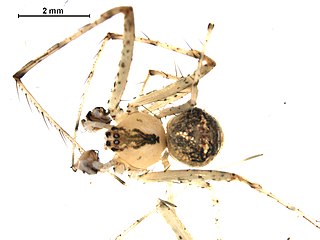
Wolf spiders are members of the family Lycosidae, from the Ancient Greek word "λύκος" meaning "wolf". They are robust and agile hunters with excellent eyesight. They live mostly in solitude and hunt alone, and do not spin webs. Some are opportunistic hunters pouncing upon prey as they find it or even chasing it over short distances. Some wait for passing prey in or near the mouth of a burrow.

The Pholcidae are a family of araneomorph spiders. The family contains over 1,800 pholcids, including those commonly known as the marbled cellar spider , daddy long-legs spider, granddaddy long-legs spider, carpenter spider, daddy long-legger, vibrating spider, gyrating spider, long daddy, and skull spider. The family, first described by Carl Ludwig Koch in 1850, is divided into 94 genera.

Allocosa brasiliensis is a burrowing wolf spider species from southern South America. Long known to science, it remained almost unstudied until its unusual sexual behavior was described in the early 21st century.

Allocosa is a spider genus of the wolf spider family, Lycosidae. The 130 or more recognized species are spread worldwide.

Catamola funerea is a species of snout moth in the genus Catamola. It was described by Francis Walker in 1863. It is found in Australia.
Agelena funerea is a species of spider in the family Agelenidae, which contains 1146 species of funnel-web spiders. It was first described by Simon, in 1909. It is primarily found in East Africa.
Allocosa dufouri is a wolf spider found in Portugal and Spain.
Allocosa caboverdensis is a species of wolf spider of the family Lycosidae, endemic to Cape Verde. The species was first described by Günter E. W. Schmidt and Rolf Harald Krause in 1995. Its species name refers to Cape Verde, where it is found.

Steatoda borealis is a species of cobweb spider in the family Theridiidae. It is found in the United States and Canada.
Meriola decepta is a species of true spider in the family Trachelidae. It is found in a range from the United States to Guatemala, Colombia, Ecuador, Peru, and Brazil.
Pardosa mercurialis is a species of wolf spider in the family Lycosidae. It is found in the United States.

Centromerus sylvaticus is a species of sheetweb spider in the family Linyphiidae. It is found in North America, Europe, Turkey, a range from Russia, China, Korea, and Japan.
Styloctetor purpurescens is a species of dwarf spider in the family Linyphiidae. It is found in the United States and Canada.

Herpyllus propinquus, the western parson spider, is a species of ground spider in the family Gnaphosidae that occurs in North America.

Xysticus triguttatus, the three-banded crab spider, is a species of crab spider in the family Thomisidae. It is found in the United States and Canada.

Mimetus puritanus is a species of pirate spider in the family Mimetidae. It is found in the United States.

Hibana gracilis, the garden ghost spider, is a species of ghost spider in the family Anyphaenidae. It is found in the United States and Canada.
Lytta funerea is a species of blister beetle in the family Meloidae. It is found in North America.
Allocosa chamberlini is a species of wolf spider in the family Lycosidae. It is found in the United States.
Allocosa sublata is a species of wolf spider in the family Lycosidae. It is found in the United States.









